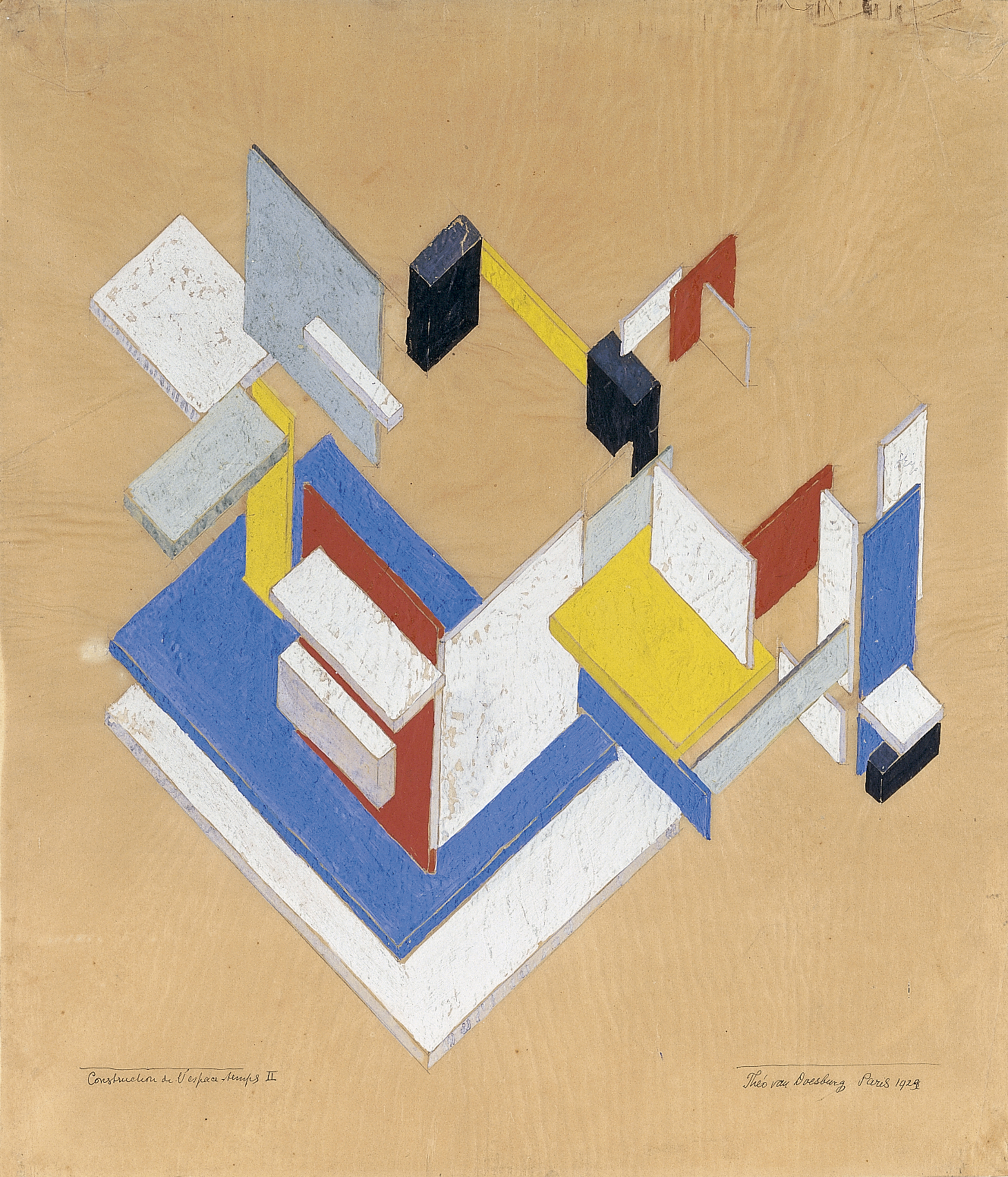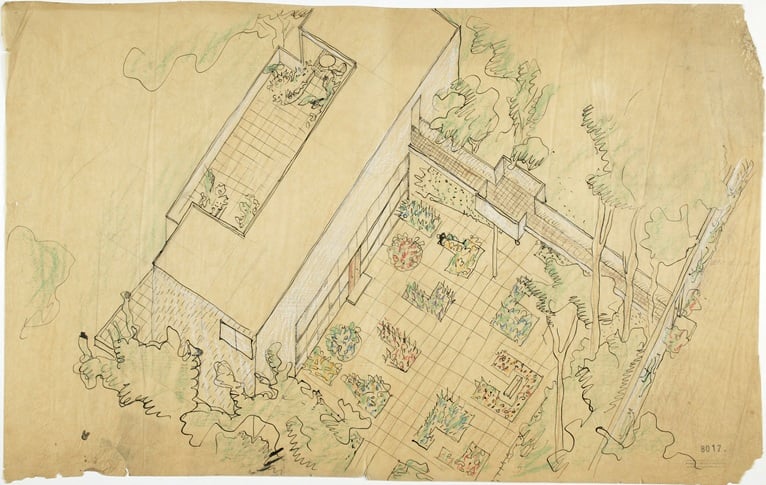Taxonomy of Virtual Spaces
In part one of this series, I collated the qualities that define an axonometric projection.
An axonometric projection is one in which a rendered object can be measured across all three axes (x axis, y axis, and z axis).
The object's axes are not parallel and not orthogonal to the projection plane, allowing three faces of the object to be seen in the image.
It is a type of parallel projection in which a 3-D object is transformed into a 2-D image on the projection plane.
It is an affine transformation, meaning that the angles between lines in the image may differ from those found on the object, but straight lines remain straight and parallel lines remain parallel.
Being a parallel projection, lines do not converge and objects do not reduce in size with distance from the projection plane.
Why Axonometry?
Many of the above qualities make axonometric projection an ideal system for defining an object for manufacture or construction. The relative lengths of each axis is preserved, so such a pictorial drawing (showing three sides of an object as a complete form) can also be used to measure each axis for the purpose of building a final product.
"Axonometric projections are used in catalog illustrations, Patent Office records, piping diagrams, furniture design, machine design, and structural design." from "Planar Geometric Projections and Viewing Transformations" by Ingrid Carlbom and Joseph Paciorek, Computing Surveys, vol. 10, no. 4 (1978) pg. 474
Two different forms of axonometry were developed by artists in China long before they were completely adapted by Europeans.
Oblique Axonometric History
 |
| Elevation oblique projection in detail from Along the River During the Qingming Festival (18th c. reproduction of 12th c. original) scroll painting, as cited in "Axonometric Projections - A Technical Overview" |
Chinese painters developed an oblique rendering style for their landscapes painted on incredibly long scrolls (the image detail above is but a tiny fraction of Along the River During the Qingming Festival, click the links above to see it in its entirety). The physical dimensions of their medium simply wouldn't work with the sort of linear perspectival rendering techniques that developed in the Italian Renaissance. This "Chinese Perspective" (something of a misnomer, as its was also adopted to great effect by artists in Japan and elsewhere) that may have evolved from Chinese architecture could portray a vast amount of terrain and present not just a single event from a single perspective, but a story that is laid out across space and time in a panoramic view. Walking the full length of one of these scroll paintings is not unlike looking out of a moving train and viewing the landscape beyond the window pane. At each point along the scroll, the viewer can experience a comprehensible scene with a clear sense of spatiality.
Note that this method renders one major face (and thus, two axes) of an object (such as a building) as parallel to the projection plane. This breaks with the second line of the definition laid above, that an object's axes may not be parallel to the projection plane. This part of the definition is needed in order to make three sides of an object visible, as a pictorial rendering (to use an engineering term). If this was an orthogonal projection, the receding edges (the orthogonals) would not be rendered as they would fall into the "z-space" of the image at 90 degree angles to the projection plane (yes, ironically, there are no orthogonals rendered in orthogonal projections). However, an oblique projection can render the faces that would normally be hidden at an oblique angle from the forward-facing face of the object. So, either the definition is wrong or an oblique style should not be considered as "axonometric" in this definition. More on this in the next post.
This Chinese style of "border painting" was introduced to Europeans in the 17th century, where it later became known as axonometric. It was probably named somewhere in continental Europe, where the formal geometric properties of this oblique method (defined above) made it well-suited for artillery, cartography, gem cutting, and other purposes ("Axonometry: A Matter of Perspective" by Jan Krikke (2000) pp 7-8).
 |
| Plan de l'abbaye de Port-Royal des Champs by Louise-Magdaleine Horthemels (ca. 1710) |
This method was also adapted for use in architectural imagery in Europe by starting with a plan view of a structure, rotating it by 45 degrees, then drawing the verticals of the structure at their true, scaled lengths (a technique also known as "military oblique").
 |
| Construction in Space-Time II by Theo van Doesburg (1924) |
The De Stijl art movement, founded in 1917 by Dutch artists Theo van Doesburg and Piet Mondrian, brought a strong architectural influence and oblique rendering to modern art as constructions of space and time.
 |
| Music pavilion for Villa Church, Ville d’Avray by Le Corbusier (1927-29) |
Le Corbusier and Mies van der Rohe followed suit, and this oblique axonometry became "nearly emblematic of modernist architecture, and it has since become an essential technique for architects and designers throughout the world" (Krikke (2000) pg. 9).
Isometric Axonometric History
 |
| Orthogonal isometric axonometry in Romance of the Three Kingdoms (ca. 15th c.) |
Chinese artists also developed an isometric style of rendering objects in space, as seen in the book illustration above. Whereas oblique projections always render one face (and two axes) of an object as parallel to the projection plane with the receding orthogonal lines rendered at an oblique angle, isometric projections render all three axes of an object at equal oblique angles to the projection plane. No face nor axis is parallel to the projection plane. This produces a more "natural" construction of space (at least, to a western viewer used to Cartesian perspectives of the Italian Renaissance), but loses the 90 degree angles between lines on major faces of objects. Note that there are no 90 degree angles in the illustration above, yet the viewer "reads" the tiles, table, steps, and walls as having rectangular shapes.
In the west, William Farish defined isometric axonometry in his paper "On Isometrical Perspective" (1820) in response to engineering and manufacturing needs of the industrial revolution (although there were hints at orthogonal axonometry centuries earlier, such as Piero Della Francesca's "Libellus de Quinque Corporibus Regolaribus" (1490), as described by Massimo Scolari in Oblique Drawing (2012) pg. 217 (image on pg. 214)). It is unknown if he was inspired by Chinese book illustrations from centuries earlier that used the same method of projection (Krikke (2000) pp 8-9).
 |
| Convex and Concave by M. C. Escher (1955) |
Dutch graphic artist M. C. Escher adopted isometry in a number of his mind-bending, illusionary renderings, creating impossible words that look like they could be real. His works simultaneously show the ambiguity and appeal of isometric projection.
 |
| Parking Lot Map by Omake (ca. 2018) |
Isometric designs continue to be useful for showing spatial relationships between objects, especially maps of our urban environments often laid out on grids. Isometry has also had a recent surge of popularity in digital graphic design.
Summary and Conclusions
Historically, two different rendering methods, oblique and isometric, were developed. Strangely, both methods originated with Chinese artists and were brought to modern art in Europe by Dutch artists. Both of these methods match the above definition for axonometry, and both methods have been referred to as "axonometric."
These two methods can be seen as either:
- Completely different methods that are incompatible.
- Related methods that are almost the same.
This depends on one's view of how 3-D objects and spaces are rendered to a 2-D plane. There are two different ways of focusing on that 3-D to 2-D transformation, either looking primarily a the structure of the 3-D scene and its relation to the 2-D plane, or primarily at the 2-D image that is the end result of the rendering.
Details on that (and what all this has to do with computer graphics) will have to wait until the next blog post...





No comments:
Post a Comment